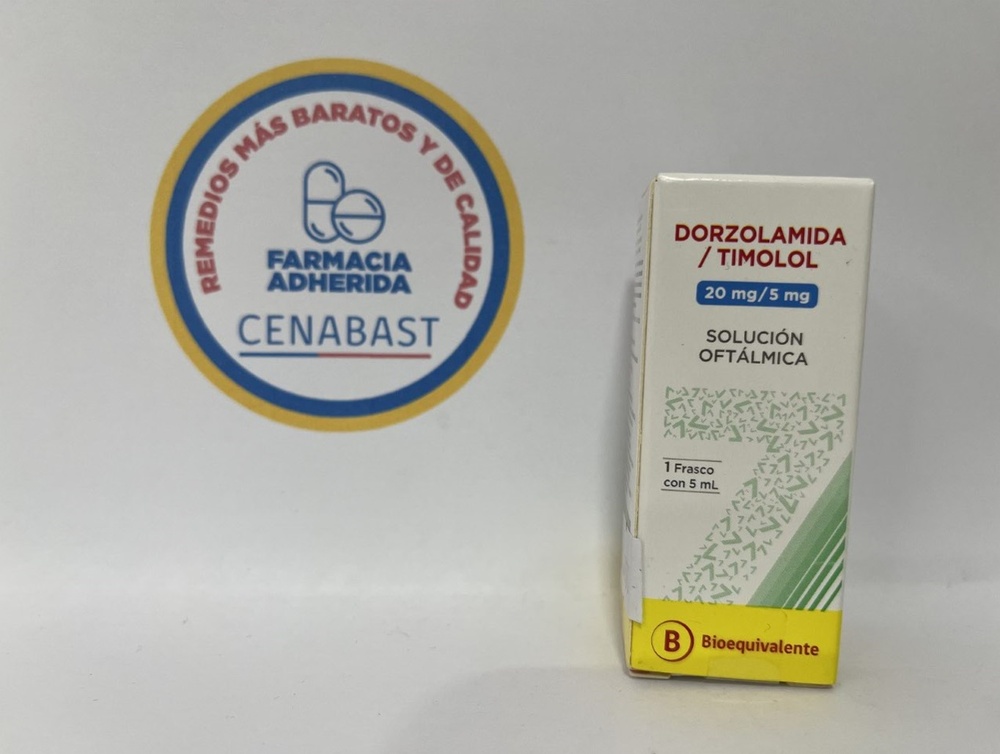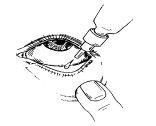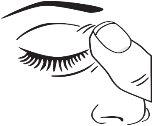

DORZOLAMIDA/TIMOLOL VIATRIS 20 mg/ml + 5 mg/ml COLÍRIO

Pergunte a um médico sobre a prescrição de DORZOLAMIDA/TIMOLOL VIATRIS 20 mg/ml + 5 mg/ml COLÍRIO

Como usar DORZOLAMIDA/TIMOLOL VIATRIS 20 mg/ml + 5 mg/ml COLÍRIO
Introdução
Prospecto: informação para o paciente
Dorzolamida/Timolol Viatris 20 mg/ml + 5 mg/ml colírio
Leia todo o prospecto detenidamente antes de começar a usar este medicamento, porque contém informações importantes para si.
- Conserva este prospecto, porque pode ter que voltar a lê-lo.
- Se tiver alguma dúvida, consulte o seu médico ou farmacêutico.
- Este medicamento foi prescrito apenas para si e não deve dá-lo a outras pessoas, mesmo que tenham os mesmos sintomas que si, porque pode prejudicá-las.
- Se experimentar efeitos adversos, consulte o seu médico ou farmacêutico, mesmo que se trate de efeitos adversos que não aparecem neste prospecto. Ver seção 4.
Conteúdo do prospecto
- O que é Dorzolamida/Timolol Viatris e para que se utiliza
- O que precisa saber antes de começar a usar Dorzolamida/Timolol Viatris
- Como usar Dorzolamida/Timolol Viatris
- Posíveis efeitos adversos
- Conservação de Dorzolamida/Timolol Viatris
- Conteúdo do envase e informação adicional
1. O que é Dorzolamida/Timolol Viatris e para que se utiliza
Dorzolamida/Timolol Viatris contém dois medicamentos: dorzolamida e timolol.
- Dorzolamida pertence a um grupo de medicamentos chamados "inibidores da anidrase carbónica".
- Timolol pertence a um grupo de medicamentos chamados "betabloqueantes".
Este medicamento reduz a pressão no olho de várias maneiras.
Dorzolamida/Timolol Viatris é prescrito para reduzir a pressão elevada no olho no tratamento do glaucoma quando o uso de um colírio betabloqueante em monoterapia não seja adequado.
2. O que precisa saber antes de começar a usar Dorzolamida/Timolol Viatris
Não use Dorzolamida/Timolol Viatris:
- Se é alérgico a dorzolamida, timolol ou a algum dos outros componentes deste medicamento (incluídos na seção 6).
- Se tem atualmente ou teve anteriormente problemas respiratórios, como asma ou bronquite obstructiva crónica grave (enfermidade pulmonar grave que pode originar sibilâncias, dificuldade para respirar e/ou tosse de longa duração).
- Se tem um ritmo cardíaco lento, insuficiência cardíaca ou alterações do ritmo cardíaco (ritmos irregulares do coração).
- Se sofre de doença ou distúrbios renais graves, ou antecedentes de pedras nos rins.
- Se tem excesso de acidez no sangue como consequência de uma acumulação de cloreto no sangue (acidose hiperclorémica).
Se não tem certeza de poder utilizar este medicamento, consulte o seu médico ou farmacêutico.
Advertências e precauções
Consulte o seu médico ou farmacêutico antes de começar a usar dorzolamida/timolol se experimenta:
- Doenças cardíacas coronárias (os sintomas podem incluir opressão ou dor no peito, dispnéia ou asfixia), insuficiência cardíaca ou pressão arterial baixa.
- Alterações da frequência cardíaca como ritmo cardíaco lento.
- Problemas respiratórios, asma ou doença pulmonar obstructiva crónica.
- Doenças devidas a uma circulação sanguínea insuficiente, como a doença ou síndrome de Raynaud.
- Diabetes ou hipoglicemia (níveis baixos de açúcar no sangue), dado que timolol pode mascarar os sinais e sintomas da hipoglicemia.
- Hiperatividade da glândula tireoide, dado que timolol pode mascarar os sinais e sintomas.
Antes de se submeter a uma operação, informe o seu médico de que está usando dorzolamida/timolol, pois timolol pode modificar os efeitos de alguns medicamentos utilizados durante a anestesia. Também, informe o seu médico de qualquer alergia ou reações alérgicas, incluindo urticária, inchaço da face, lábios, língua e/ou garganta; pois poderiam provocar dificuldade para respirar ou engolir.
Informe o seu médico se tem fraqueza muscular ou se lhe foi diagnosticada miastenia gravis (fraqueza muscular).
Informe o seu médico imediatamente se se produzir irritação ocular ou ocorrer qualquer reação nova no olho, como poderia ser vermelhidão ou inflamação da pálpebra.
Se suspeita que dorzolamida/timolol está provocando uma reação alérgica ou hipersensibilidade (por exemplo, erupção na pele, reação cutânea grave ou vermelhidão e coceira no olho), suspenda o uso deste medicamento e entre em contato imediatamente com o seu médico.
Informe o seu médico se desenvolve uma infecção no olho, sofre uma lesão no olho, se submete a uma operação no olho, experimenta qualquer outra reação ou os sintomas pioram.
Instilar dorzolamida/timolol no olho pode afetar o organismo em sua totalidade.
Crianças
Dispõe-se de experiência limitada com o uso de dorzolamida/timolol em lactentes, em crianças e adolescentes.
Pacientes de idade avançada
Em estudos com dorzolamida/timolol, os efeitos de dorzolamida/timolol foram semelhantes tanto nos pacientes de idade avançada como nos mais jovens.
Pacientes com insuficiência hepática
Informe o seu médico sobre qualquer problema hepático que tenha atualmente ou tenha tido no passado.
Atletas
Este medicamento contém timolol, que pode produzir um resultado positivo nos testes de controle de dopagem.
Outros medicamentos eDorzolamida/Timolol Viatris
Dorzolamida/timolol pode afetar ou ser afetado por outros medicamentos que esteja usando, incluindo outros colírios para o tratamento do glaucoma. Informe o seu médico se está utilizando ou planeia utilizar medicamentos para baixar a pressão sanguínea, medicamentos para o coração ou medicamentos para tratar a diabetes. Comunique ao seu médico ou farmacêutico se está usando, usou recentemente ou poderia ter que usar qualquer outro medicamento, mesmo os adquiridos sem receita médica. Isso é particularmente importante se está:
- Tomando medicamentos para baixar a tensão ou tratar uma doença cardíaca (por exemplo, bloqueantes dos canais de cálcio, betabloqueantes ou digoxina).
- Tomando medicamentos utilizados para tratar os ritmos cardíacos irregulares ou alterados, como bloqueantes dos canais de cálcio, betabloqueantes ou digoxina.
- Usando outro colírio que contenha betabloqueantes.
- Tomando outro inibidor da anidrase carbónica tal como acetazolamida.
- Tomando inibidores da monoamino oxidase (IMAO), que se utilizam para tratar a depressão.
- Tomando um medicamento parasimpaticomimético, que pudesse ter sido prescrito para ajudar a eliminar urina. Os parasimpaticomiméticos são também um tipo particular de medicamento que em algumas ocasiões se utiliza para ajudar a restaurar os movimentos normais através do intestino.
- Tomando opiáceos, como morfina, para o tratamento da dor de moderada a intensa.
- Tomando medicamentos para tratar a diabetes.
- Tomando antidepressivos, conhecidos como fluoxetina ou paroxetina.
- Tomando um medicamento sulfá.
- Tomando quinina (utilizado para tratar doenças do coração ou alguns tipos de malária).
Gravidez e amamentação
Se está grávida ou em período de amamentação, acredita que possa estar grávida ou tem intenção de engravidar, consulte o seu médico ou farmacêutico antes de utilizar este medicamento.
Não utilize dorzolamida/timolol se está grávida a não ser que o seu médico o considere necessário.
Não utilize dorzolamida/timolol se está amamentando o seu filho. Timolol pode chegar ao leite materno. Consulte o seu médico antes de tomar qualquer medicamento se está amamentando.
Condução e uso de máquinas
Não se realizaram estudos dos efeitos sobre a capacidade para conduzir ou utilizar máquinas. Há efeitos adversos associados a dorzolamida/timolol, como visão borrosa, que podem afetar a sua capacidade para conduzir e/ou usar máquinas. Não conduza nem maneje ferramentas ou máquinas até que se encontre bem ou a sua visão seja correta.
Dorzolamida/TimololViatriscontém cloreto de benzalconio
Este medicamento contém 0,15 mg de cloreto de benzalconio em cada mililitro de solução oftálmica.
O cloreto de benzalconio pode ser absorvido pelas lentes de contato macias alterando a sua cor. Retire as lentes de contato antes de usar este medicamento e espere 15 minutos antes de voltar a colocá-las.
O cloreto de benzalconio pode causar irritação ocular, especialmente se padece de olho seco ou outras doenças da córnea (camada transparente da zona frontal do olho). Consulte o seu médico se sentir uma sensação estranha, coceira ou dor no olho após usar este medicamento.
3. Como usar Dorzolamida/Timolol Viatris
Siga exatamente as instruções de administração deste medicamento indicadas pelo seu médico. Consulte o seu médico ou farmacêutico se tiver dúvidas.
A posologia apropriada e a duração do tratamento serão estabelecidas pelo seu médico.
A dose recomendada é de uma gota no olho ou olhos afetados duas vezes ao dia, por exemplo, pela manhã e à noite.
Se utilizar este medicamento com outro colírio, deixe pelo menos 10 minutos entre a aplicação de dorzolamida/timolol e o outro medicamento.
Não altere a dose deste medicamento sem consultar o médico. Se deve interromper o tratamento, entre em contato imediatamente com o seu médico.
Não deixe que a ponta do recipiente toque o olho ou a zona que o rodeia. Pode contaminar-se com bactérias capazes de causar infecções oculares que originem graves danos nos olhos, e até mesmo a perda da visão. Para evitar uma possível contaminação do recipiente, lave as mãos antes de utilizar este medicamento e evite que a ponta do recipiente entre em contato com qualquer superfície. Se acredita que o seu medicamento possa ter-se contaminado, ou se desenvolve uma infecção no olho, consulte imediatamente o seu médico para saber se deve continuar usando este frasco.
Para assegurar uma dose correta - não alargue o orifício da ponta do dispensador.
Instruções de uso:
Não use este colírio se a tira de plástico de segurança não está ou está quebrada. Para abrir o envase pela primeira vez, arranque a tira de plástico de segurança.

Cada vez que use este medicamento:
- Lave as mãos.
- Abra o frasco. Tenha cuidado para que a ponta do frasco não toque o olho, nem a pele de volta, nem os dedos.
- Incline a cabeça para trás e mantenha o frasco boca abajo sobre o olho.
- Puxe suavemente a pálpebra inferior para baixo e olhe para cima. Segure e aperte ligeiramente o envase pelos lados, permitindo que caia uma gota no espaço entre a pálpebra inferior e o olho.
- Feche o olho e pressione a esquina interior do olho com o seu dedo durante dois minutos. Isso ajuda a que o medicamento não vá para o resto do corpo.
- Repita os passos 3 - 5 no outro olho se assim o indicar o seu médico.
- Voltar a colocar a tampa no frasco e fechar o frasco hermeticamente após o uso.

Se usa mais Dorzolamida/TimololViatrisdo que deve
É importante manter a dose que o seu médico lhe prescreveu. Se se aplicam demasiadas gotas no olho ou engole algo do conteúdo do frasco, pode sentir-se mal, por exemplo, pode sofrer de dor de cabeça, sentir-se cansado ou mareado, sentir tontura, ter dificuldades para respirar, sofrer de dispnéia ou notar que o coração late mais devagar. Se sentir algum desses efeitos, deve procurar atendimento médico imediatamente.
Em caso de sobredose ou ingestão acidental, consulte imediatamente o seu médico ou farmacêutico ou ligue para o Serviço de Informação Toxicológica, telefone: 91 562 04 20, indicando o medicamento e a quantidade ingerida.
Se esqueceu de usar Dorzolamida/Timolol Viatris
É importante administrar este medicamento como lhe indicou o seu médico.
Se esqueceu de uma dose, deve administrá-la o mais breve possível. No entanto, se é quase a hora da próxima dose, não se administre a dose esquecida e continue com o programa de doses previsto normalmente.
Não use uma dose dupla para compensar as doses esquecidas.
Se interromper o tratamento com Dorzolamida/Timolol Viatris
Se quer interromper o tratamento com este medicamento, consulte primeiro o médico.
Se tiver alguma outra dúvida sobre o uso deste medicamento, pergunte ao seu médico ou farmacêutico.
4. Possíveis efeitos adversos
Tal como todos os medicamentos, este medicamento pode produzir efeitos adversos, embora nem todas as pessoas os sofram.
Efeitos adversos graves
Se experimentar algum dos seguintes efeitos adversos, interrompa o uso deste medicamento e fale imediatamente com o seu médico, pois poderiam ser sinais de uma reação ao medicamento.
Podem ocorrer reações alérgicas gerais, incluindo inflamação sob a pele em áreas como a face e extremidades, e que podem obstruir vias aéreas, o que pode provocar dificuldade em engolir, falta de ar, urticária ou erupção cutânea, erupção localizada ou generalizada, picor, reações graves, repentinas e fatais.
Geralmente, pode continuar usando as gotas, a menos que os efeitos sejam graves. Se está preocupado, consulte com o seu médico ou farmacêutico. Não deixe de usar dorzolamida/timolol sem falar antes com o seu médico.
Foram notificados os seguintes efeitos adversos com dorzolamida/timolol ou com um dos seus componentes nos ensaios clínicos ou durante a experiência pós-comercialização.
Muito frequentes(podem afetar mais de 1 de cada 10 pessoas)
- Queimadura e coceira nos olhos, alteração do gosto.
Frequentes(podem afetar até 1 de cada 10 pessoas)
- Vermelhidão em e ao redor do olho(s).
- Olho(s) lacrimejante e com coceira.
- Erosão da córnea (dano na camada frontal do globo ocular).
- Inflamação e/ou irritação em e ao redor do olho(s).
- Sensação de ter algo no olho.
- Diminuição da sensibilidade da córnea (não perceber a presença de algo no olho e não sentir dor).
- Dor no olho.
- Olhos secos.
- Visão borrada.
- Dor de cabeça.
- Sinusite (uma sensação de tensão ou plenitude no nariz).
- Sensação de mal-estar (náuseas).
- Debilidade/cansancio (fadiga).
Pouco frequentes(podem afetar até 1 de cada 100 pessoas)
- Tontura.
- Depressão.
- Inflamação do íris.
- Alterações da visão incluídas as modificações da refração (em certos casos devido à suspensão da medicação para tratar uma contração excessiva da pupila).
- Frequência cardíaca lenta.
- Desmaios.
- Falta de ar.
- Sentir que lhe falta o ar.
- Indigestão.
- Cálculos renais (muitas vezes caracterizados pelo início súbito de uma dor espasmódica e muito intensa na zona lombar e/ou lateral, ingles ou abdômen).
Raros(podem afetar até 1 de cada 1.000 pessoas)
- Lúpus eritematoso sistémico (uma doença imunológica que pode originar uma inflamação dos órgãos internos) com sintomas como dor articular (semelhante à artrite reumatoide), febre, variações no hemograma e erupções cutâneas.
- Formigamento ou entorpecimento das mãos ou dos pés.
- Dificuldade para dormir.
- Pesadelos.
- Perda de memória.
- Aumento dos sinais e sintomas de miastenia gravis (distúrbio muscular).
- Diminuição das ganas de ter sexo.
- Acidente vascular cerebral.
- Miopia que pode desaparecer ao cessar o tratamento.
- Desprendimento da camada debaixo da retina que contém vasos sanguíneos após a cirurgia de filtração, o que pode provocar alterações visuais.
- Queda das pálpebras (provocando que os olhos estejam meio fechados).
- Visão dupla.
- Formação de crostas nas pálpebras.
- Inflamação da córnea (com sintomas de alterações visuais).
- Pressão baixa no olho.
- Zumbidos nos ouvidos.
- Pressão arterial baixa.
- Mudanças no ritmo cardíaco ou na velocidade dos batimentos.
- Insuficiência cardíaca congestiva (doença do coração com dificuldade para respirar e inchaço dos pés e das pernas devido à acumulação de líquido).
- Edema (acumulação de líquido).
- Isquemia cerebral (diminuição do fluxo sanguíneo para o cérebro).
- Dor no peito.
- Ritmo do coração mais rápido e/ou irregular (palpitações).
- Ataque cardíaco.
- Fenômeno de Raynaud, mãos e pés inchados ou frios e diminuição da circulação nos braços e pernas.
- Cãibras na perna e/ou dor de perna quando se caminha (claudicação).
- Secreção nasal ou nariz entupido.
- Sangramento no nariz.
- Constrição das vias respiratórias nos pulmões.
- Tosse.
- Irritação da garganta.
- Boca seca.
- Diarréia.
- Dermatite de contato.
- Perda de cabelo.
- Erupção cutânea com um aspecto branco prateado (sarpullido psoriasiforme).
- Doença de Peyronie (que pode produzir uma curvatura do pênis).
- Reações de tipo alérgico, tais como erupção cutânea, ronchas, coceira, em casos raros, possível inchaço dos lábios, olhos e boca, jadeamento, ou reações cutâneas graves (síndrome de Stevens-Johnson, necrólise epidérmica tóxica).
Como outros medicamentos que se aplicam aos olhos, timolol é absorvido no sangue. Isso pode causar efeitos adversos semelhantes aos que aparecem com os agentes betabloqueantes orais. A incidência de efeitos adversos após a administração oftálmica tópica é mais baixa do que quando os medicamentos, por exemplo, são tomados pela boca ou são injetados.
Os efeitos adversos adicionais listados incluem reações que aparecem dentro da classe de betabloqueantes quando se usam para tratar distúrbios oculares.
Frequência não conhecida(não pode ser estimada a partir dos dados disponíveis)
- Níveis de glicose baixos no sangue.
- Insuficiência cardíaca.
- Um tipo de alteração do ritmo cardíaco.
- Dor abdominal.
- Vômitos.
- Dor muscular não provocada pelo exercício físico.
- Disfunção sexual.
- Alucinações.
- Sensação de corpo estranho no olho (sensação de ter algo no olho).
- Aumento da frequência cardíaca.
- Aumento da pressão arterial.
Comunicação de efeitos adversos
Se experimentar qualquer tipo de efeito adverso, consulte o seu médico ou farmacêutico, mesmo que se trate de possíveis efeitos adversos que não aparecem neste prospecto. Também pode comunicá-los diretamente através do Sistema Espanhol de Farmacovigilância de Medicamentos de Uso Humano: https://www.notificaram.es. Mediante a comunicação de efeitos adversos, você pode contribuir para proporcionar mais informações sobre a segurança deste medicamento.
5. Conservação de Dorzolamida/Timolol Viatris
Mantenha este medicamento fora da vista e do alcance das crianças.
Não utilize este medicamento após a data de validade que aparece na etiqueta do frasco e na caixa após CAD ou EXP. A data de validade é o último dia do mês que se indica.
Este medicamento não requer nenhuma temperatura especial de conservação. Conservar no envase original para protegê-lo da luz e da umidade.
Dorzolamida/Timolol Viatris deve ser usado em um prazo não superior a 28 dias após a primeira abertura do frasco. Portanto, deve ser descartado às quatro semanas após a primeira abertura do frasco, mesmo que ainda reste solução. Para ajudá-lo a lembrar, anote a data em que o abriu no espaço do envase.
Os medicamentos não devem ser jogados nos esgotos nem na lixeira. Deposite os envases e os medicamentos que não precisa no Ponto SIGRE da farmácia. Em caso de dúvida, pergunte ao seu farmacêutico como se livrar dos envases e dos medicamentos que não precisa. Dessa forma, ajudará a proteger o meio ambiente.
6. Conteúdo do envase e informações adicionais
Composição de Dorzolamida/Timolol Viatris
- Os princípios ativos são dorzolamida e timolol. Cada ml contém 20 mg de dorzolamida (como dorzolamida hidrocloruro) e 5 mg de timolol (como timolol maleato).
- Os demais componentes são manitol (E421), hidroxietil celulose, cloruro de benzalconio (como conservante; ver seção 2 “Dorzolamida/Timolol Viatris contém o conservante cloruro de benzalconio”), citrato de sódio (E331), hidróxido de sódio (E524) e água para preparações injetáveis.
Aspecto do produto e conteúdo do envase
O medicamento é um colírio em solução estéril, transparente, ligeiramente viscosa, aquosa incolor.
Dorzolamida/Timolol Viatris é apresentado em um frasco branco opaco de polietileno de densidade média com um gotero de ponta selada de baixa densidade e uma tampa de polietileno de alta densidade com uma tira de segurança, que contém 5 ml de solução oftálmica.
Tamanhos de envase: 1, 3 ou 6 frascos de 5 ml cada um.
Pode ser que apenas alguns tamanhos de envases sejam comercializados.
Titular da autorização de comercialização e responsável pela fabricação
Titular da autorização de comercialização:
Viatris Limited
Damastown Industrial Park
Mulhuddart, Dublín 15
Dublim
Irlanda
Responsável pela fabricação:
Pharmathen S.A.
6 Dervenakion str., 15351 Pallini, Attiki
Grécia
ou
Famar S.A.
Planta A
63 Agiou Dimitriou Street, 174 56 Alimos
Grécia
ou
Viatris Sante
1 Rue de Turin
69007 Lyon
França
Podem solicitar mais informações sobre este medicamento dirigindo-se ao representante local do titular da autorização de comercialização:
Viatris Pharmaceuticals, S.L.U.
C/ General Aranaz, 86
28027 - Madrid
Espanha
Este medicamento está autorizado nos estados membros do Espaço Econômico Europeu e no Reino Unido (Irlanda do Norte) com os seguintes nomes:
Áustria: Dorzolamid + Timolol Viatris 20 mg/ml + 5 mg/ml - Augentropfen
Bélgica: TensocViatris 20 mg/ml + 5 mg/ml oogdruppels, oplossing
Dinamarca: Tirzopt
Espanha: Dorzolamida/Timolol Viatris 20 mg/ml + 5 mg/ml colírio em solução
França: Dorzolamide/Timolol Viatris 20 mg/ml + 5 mg/ml, collyre en solution
Itália: Dorzolamide e timololo Mylan Generics
Países Baixos: Dorzolamide/Timolol Viatris 20/5 mg/ml, oogdruppels, oplossing
Portugal: Timolol + Dorzolamida Mylan
Reino Unido: Dorzolamide/Timolol 20 mg/ml + 5 mg/ml eye drops, solution
(Irlanda do Norte)
República Checa: Dorzogen Combi
Data da última revisão deste prospecto:janeiro 2023
A informação detalhada deste medicamento está disponível na página web da Agência Espanhola de Medicamentos e Produtos Sanitários (AEMPS) https://www.aemps.gob.es/

Quanto custa o DORZOLAMIDA/TIMOLOL VIATRIS 20 mg/ml + 5 mg/ml COLÍRIO em Espanha em 2025?
O preço médio do DORZOLAMIDA/TIMOLOL VIATRIS 20 mg/ml + 5 mg/ml COLÍRIO em novembro de 2025 é de cerca de 12.11 EUR. Os valores podem variar consoante a região, a farmácia e a necessidade de receita. Confirme sempre com uma farmácia local ou fonte online para obter informações atualizadas.
- País de registo
- Preço médio em farmácia12.11 EUR
- Substância ativa
- Requer receita médicaSim
- Fabricante
- Esta informação é apenas para referência e não constitui aconselhamento médico. Consulte sempre um médico antes de tomar qualquer medicamento. A Oladoctor não se responsabiliza por decisões médicas baseadas neste conteúdo.
- Alternativas a DORZOLAMIDA/TIMOLOL VIATRIS 20 mg/ml + 5 mg/ml COLÍRIOForma farmacêutica: COLÍRIO, 10 mg/ml + 5 mg/mlSubstância ativa: timolol, combinationsFabricante: Novartis Europharm LimitedRequer receita médicaForma farmacêutica: COLÍRIO, 0,3 mg/ml + 5 mg/mlSubstância ativa: timolol, combinationsFabricante: Brill Pharma S.L.Requer receita médicaForma farmacêutica: COLÍRIO, 0,3 mg/ml + 5 mg/mlSubstância ativa: timolol, combinationsFabricante: Laboratorio Stada S.L.Requer receita médica
Alternativas a DORZOLAMIDA/TIMOLOL VIATRIS 20 mg/ml + 5 mg/ml COLÍRIO noutros países
As melhores alternativas com o mesmo princípio ativo e efeito terapêutico.
Alternativa a DORZOLAMIDA/TIMOLOL VIATRIS 20 mg/ml + 5 mg/ml COLÍRIO em Polónia
Alternativa a DORZOLAMIDA/TIMOLOL VIATRIS 20 mg/ml + 5 mg/ml COLÍRIO em Ukraine
Médicos online para DORZOLAMIDA/TIMOLOL VIATRIS 20 mg/ml + 5 mg/ml COLÍRIO
Avaliação de posologia, efeitos secundários, interações, contraindicações e renovação da receita de DORZOLAMIDA/TIMOLOL VIATRIS 20 mg/ml + 5 mg/ml COLÍRIO – sujeita a avaliação médica e regras locais.














